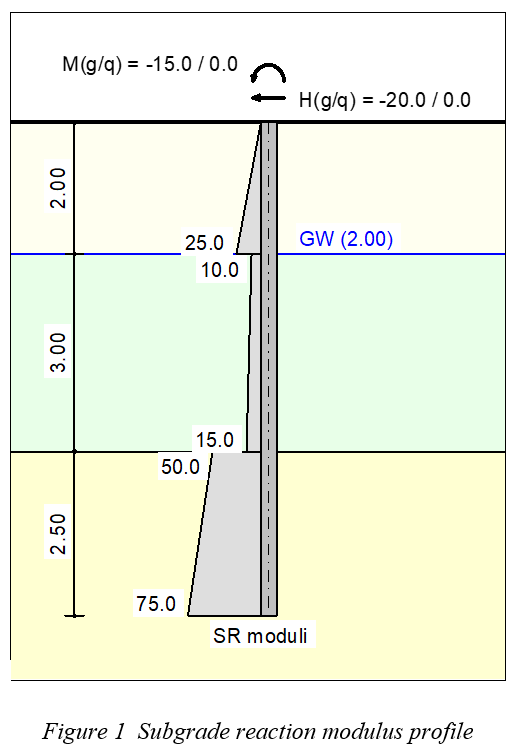GGU-LATPILE: Preface
GGU-LATPILE allows analysis and design of piles subjected to lateral loads and moments. For analysis both the partial safety factors to EC 7 and the global safety factors to DIN 1054 (old) may be taken into consideration. Subgrade reaction moduli can be applied to user-defined, linearly variable sections over the length of the pile. By thus dividing the pile into several sections it is possible to model any subgrade reaction modulus profile.

Elastic analysis supplies the soil stress determined from the product of the subgrade reaction
modulus and the deformation along the length of the pile. This elastic stress must not exceed
the passive earth pressure that can be developed in front of the pile. By means of iteration,
GGU-LATPILE reduces the subgrade reaction modulus such that this condition is adhered to. GGU-LATPILE calculates both passive (various methods of analysis can be selected) and active earth pressures.
As an alternative to the subgrade reaction modulus method, you can also perform a pile analysis using the p-y method.
The Code of Practice published by Forschungsgesellschaft für Straßen- und Verkehrswesen (FGSV): M EBGS-Lsw - Code of Practice for the Design and Analysis of Footings and Steel Posts for Noise Abatement Walls and Bird Overfly Aids on Roads (Edition 2018, FGSV no. 552) has been incorporated for the purposes of analysing noise abatement walls.
If you are already working with GGU-CONNECT, you can also import soil properties from your subsoil layer model that you have created in GGU-CONNECT.
The application is designed to allow simple data input or modification. The input is immediately shown on the screen, giving you optimum control over what you are doing. Reading of the manual can mostly be dispensed with, because
"?" buttons ![]()
dealing with almost all geotechnical and program-specific problems are available in the dialog boxes. You are presented with the necessary information by clicking the "?" button.
Graphics output supports the true-type fonts supplied with WINDOWS, so that excellent layout is guaranteed. Colour output and any graphics (e.g. files in formats BMP, JPG, PSP, TIF, etc.) are supported. PDF and DXF files can also be imported by means of the integrated Mini-CAD module (see the "Mini-CAD" manual).
The program has been thoroughly tested. No faults have been found. Nevertheless, liability for completeness and correctness of the program and the manual, and for any damage resulting from incompleteness or incorrectness, cannot be accepted.
